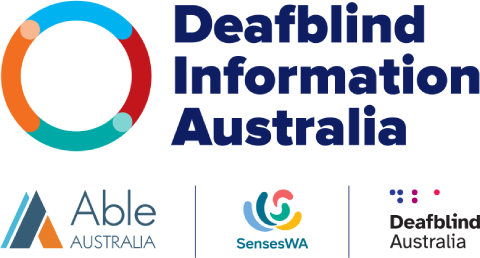Early Communication
This page has information to support families, staff and other people who interact with people with deafblindness who are ‘early communicators’. They may be:
- infants,
- children, or
- adults
who do not communicate using speech or sign. They could also be just starting to use speech or sign, or only use a few words or key signs.
Webinar | From emerging gestures to tactile sign language
Steve Rose explains development of communication in people born deafblind. He talks about
- early communication
- tactile language
- gesture and expressions
- back and forth flow of communication
Download From emerging gestures to tactile sign language webinar transcript (Word docx, 74KB)
Webinar | Introducing sign and other communication to children with deafblindness and their families
Rob Last and Madelene Rich, share experiences from their work and personal life. They describe different types of communication for children with deafblindness and their processes for introducing sign language. The second video is a recording of the Question and Answer session.
Webinar | Creative Arts Therapy and congenital deafblindness
Clare Fraser talks about the role and processes of a Creative Arts Therapist. She describes how this therapy can enhance relationships, connection and communication. She gives examples from her work with people born deafblind. The second video is a recording of the Question and Answer session.
Download Creative Arts Therapy and congenital deafblindness webinar transcript (Word docx, 242kb)
Download Creative Arts Therapy and congenital deafblindness webinar Q&A transcript (Word docx 227kb)
Webinar | Less ambiguity and more opportunities for closure: Towards a better understanding of deafblindness
The need for closure is a desire for a clear, firm answer or peaceful resolution to a question, problem or confusing event. Humans have a need for closure. Maurice Belote describes how people with deafblindness of all ages often experience lack of closure and the stress this can cause. He encourages the audience to think about when and how closure can be communicated to people of all ages and abilities. The second video is a recording of the Questions and Answer session.
Webinar | Hand under hand
Hand-under-hand is a technique used to guide exploration. This method helps in developing trust and supporting shared experiences. It encourages independence whilst being respectful and inviting. The content in the webinar below includes:
- overview of hand-under-hand
- the role of hand-under-hand in informal and formal communication
- examples of interactions
- case studies
The second video is a recording of the Questions and Answer session.
Download Hand-under-hand webinar transcript (Word docx, 236KB)
Download Hand-under-hand webinar Q&A transcript (Word docx, 230KB)
Webinar | Decision-making in deafblind communication
There are many communication options available to people with deafblindness. An important part of exploring communication is how this is supported. Also, how language foundations are developed. The below webinar covers:
- factors shaping decisions on which communication method to use
- steps to language for someone with congenital deafblindness
- what to think about when sending messages through hearing, vision and touch
The second video is a recording of the Questions and Answer session.
Download Decision-making in deafblind communication webinar transcript (Word docx, 248KB)
Download Decision-making in deafblind communication webinar Q&A transcript (Word docx, 227KB)
Webinar | High quality interactions
High quality interactions are essential for the development of communication in children with deafblindness. This is especially the case during early communication.
There are some key factors to consider during interactions. These include:
- tuning in to emotion,
- the importance of mirroring,
- turn taking,
- novelty – adding something new, and
- co-regulation of positioning and timing.
Download High quality interactions webinar transcript (Word docx, 252KB)
